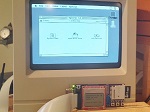

The Basics of BASICįrom the late 1970s through the early ’80s, most personal computers included a programming language known as BASIC, an acronym for Beginners’ All-purpose Symbolic Instruction Code. A typical Apple II computer came equipped with 48 or 64 KB of RAM, and a 1.0 CPU. Over the course of its approximate 16-year lifespan (it was discontinued in 1993), the Apple II platform hosted seven versions of Wozniak’s original computer design. The Apple II was a stunning breakout success for Apple. Apple co-founder, Steve Wozniak’s, wizardry with circuit design allowed all these features to fit into a small desktop machine with a lightweight plastic case. It also had seven internal expansion slots that worked with the world’s least expensive floppy disk system at that time, the Disk II. The Apple II stood out because of its low cost and color graphics. Prior to this, most computers were expensive and only owned (or shared) by large organizations. These personal computers allowed people to own and operate their own machines with relative ease.

Introduced in 1977, the Apple II was launched as part of a class of small, inexpensive computers made possible by microprocessor technology. Why the Apple II Was So Important Apple, Inc.


 0 kommentar(er)
0 kommentar(er)
